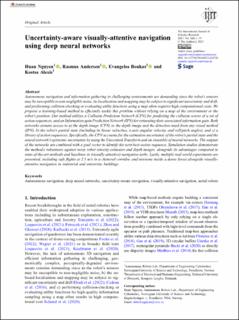| dc.contributor.author | Nguyen, Dinh Huan | |
| dc.contributor.author | Andersen, Rasmus | |
| dc.contributor.author | Boukas, Evangelos | |
| dc.contributor.author | Alexis, Konstantinos | |
| dc.date.accessioned | 2024-01-16T09:06:28Z | |
| dc.date.available | 2024-01-16T09:06:28Z | |
| dc.date.created | 2023-11-18T21:33:48Z | |
| dc.date.issued | 2023 | |
| dc.identifier.issn | 0278-3649 | |
| dc.identifier.uri | https://hdl.handle.net/11250/3111674 | |
| dc.description.abstract | Autonomous navigation and information gathering in challenging environments are demanding since the robot’s sensors may be susceptible to non-negligible noise, its localization and mapping may be subject to significant uncertainty and drift, and performing collision-checking or evaluating utility functions using a map often requires high computational costs. We propose a learning-based method to efficiently tackle this problem without relying on a map of the environment or the robot’s position. Our method utilizes a Collision Prediction Network (CPN) for predicting the collision scores of a set of action sequences, and an Information gain Prediction Network (IPN) for estimating their associated information gain. Both networks assume access to a) the depth image (CPN) or the depth image and the detection mask from any visual method (IPN), b) the robot’s partial state (including its linear velocities, z-axis angular velocity, and roll/pitch angles) and c) a library of action sequences. Specifically, the CPN accounts for the estimation uncertainty of the robot’s partial state and the neural network’s epistemic uncertainty by using the Unscented Transform and an ensemble of neural networks. The outputs of the networks are combined with a goal vector to identify the next-best action sequence. Simulation studies demonstrate the method’s robustness against noisy robot velocity estimates and depth images, alongside its advantages compared to state-of-the-art methods and baselines in (visually-attentive) navigation tasks. Lastly, multiple real-world experiments are presented, including safe flights at 2.5 m/s in a cluttered corridor, and missions inside a dense forest alongside visually-attentive navigation in industrial and university buildings. | en_US |
| dc.language.iso | eng | en_US |
| dc.rights | Navngivelse 4.0 Internasjonal | * |
| dc.rights.uri | http://creativecommons.org/licenses/by/4.0/deed.no | * |
| dc.title | Uncertainty-Aware Visually-Attentive Navigation Using Deep Neural Networks | en_US |
| dc.title.alternative | Uncertainty-Aware Visually-Attentive Navigation Using Deep Neural Networks | en_US |
| dc.type | Peer reviewed | en_US |
| dc.type | Journal article | en_US |
| dc.description.version | publishedVersion | en_US |
| dc.source.journal | The international journal of robotics research | en_US |
| dc.identifier.cristin | 2198435 | |
| dc.relation.project | Andre: Air Force Office of Scientific Research FA8655-21-1-7033 | en_US |
| dc.relation.project | Norges forskningsråd: 321435 | en_US |
| cristin.ispublished | false | |
| cristin.fulltext | postprint | |
| cristin.qualitycode | 1 | |

